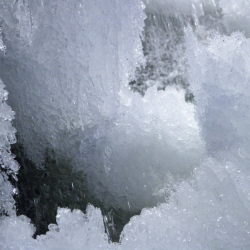
We measure changes in ice sheets via missions such as NASA’s Gravity Recovery and Climate Experiment satellite, or by flying planes over a region. But there could be a better way; scientists are getting positive results from a new method that tracks seismic vibrations caused by ocean waves to measure changes in ice volume.
The method works by listening for the tiny vibrations, or seismic waves, continuously caused as ocean waves crash against the shoreline. That signal is too small for us to feel, but it can be picked up by precise seismic sensors across the globe, even a long way from the ocean, in the middle of continents.
The speed at which the seismic waves move is determined by how porous the Earth’s crust is at any given point, the more porous the rock, the slower the waves move. The MIT researchers believed that ice sheets might also impact the speed of the waves, with their weight pushing down on the pores, opening or closing them depending on whether the ice is growing or shrinking in size. That might make it possible to track changes in the volume of the ice by carefully measuring the waves.
The use of seismic sensors would be advantageous over existing methods of tracking ice sheets. Taking measurements using laser altimetry from planes can only be done a few times a year, and satellites take an entire month to complete one full set of data for the planet. On the other hand, the sensors could collect data constantly, allowing for a lot more information to be gathered over shorter periods of time.
The team gathered data from a small network of seismic sensors on the western side of Greenland’s ice sheet, with recordings taken between January 2012 and January 2014. Studying the data, the team noticed very small changes in seismic wave velocity of around one percent.
The most significant change was observed between the data for 2012 and that for 2013, with the measurements tallying well with those made by the GRACE satellite, which recorded much higher melting rates in 2012 than 2013.
Using the data, the team built a model that used the wave velocity to predict ice sheet volume. That data correlated extremely well with the satellite data, matching it to an accuracy of 91 percent.
With the method validated by the study, the researchers are now looking to step things up, with plans to use existing seismic networks, which have never been utilized in such a way, to track seasonal changes in Antarctic ice. If that project works out, the team hopes to initiate much larger-scale efforts, covering large areas of the coasts of both Antarctica and Greenland.
"If you have very good coverage, like an array with separations of about 70 kilometers, we could in principle make a map of the regions that have more melting than others, using this monitoring, and maybe better refine models of how ice sheets respond to climate change," said study member German Prieto.
